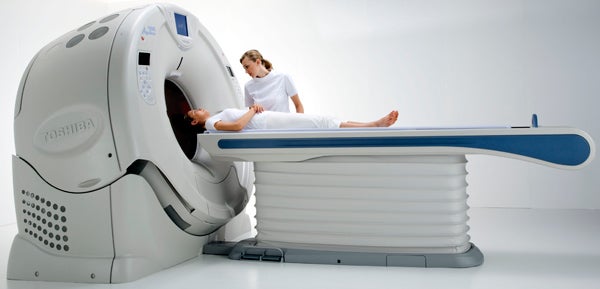Saving More Lives by Building a Better Scanner
A new body scanner captures tumors, blood clots and leaky arteries in action

To grasp the power of Toshiba’s new Aquilion ONE computed-tomography (CT) scanner, imagine facing a picturesque beach. Your camera doesn’t have a panoramic function, so you take snapshots pointing to the left, the center, and the right. You tape the photographs together and it looks gorgeous, sure, but you’re missing the action of the waves crashing on the sand.
Now imagine that you’re facing that same beach with a widescreen high-definition video recorder. The whole shoreline is in your lens, and you’re recording it all—the diameter of every grain of sand, the movement of every wave—in an image that can later be viewed from any angle you choose. That’s what the ONE does when taking pictures of your innards.
The machine, which took 10 years and $500 million to develop, could change the way doctors diagnose and treat such illnesses as stroke and heart attack, making many standard tests unnecessary. Take heart attacks. A guy walks into the ER with a crushing pain in his chest. Before the ONE, doctors might have ordered an EKG, a CT scan, a nuclear study and perhaps even an invasive catheterization. The tests would take days and cost thousands.
The ONE does nearly everything—filming, in high-resolution, dynamic volume imagery, how organs function—in 20 minutes or less, for under $1,000 and with 80 percent fewer x-rays than other CT scanners.

The Doctor Will See You Now
Why the vast difference? A current CT machine takes pictures of organs by the slice, and the picture is stitched together. Although this method is great for spotting changes and tumors on organs, it doesn’t convey how the organ is functioning. The ONE, using 320 ultra-high-resolution x-ray detectors, each half a millimeter wide, rotates once around an organ and shows not just what it looks like but its blood flow too.
In the U.S., Toshiba has sold the $2.8-million machines to select hospitals in Baltimore, Boston and Las Vegas. The ONE costs about twice as much as a traditional multi-slice CT scanner, but company officials say it will end up saving money and physicians’ time because so many auxiliary tests won’t be needed. Toshiba expects to sell at least 200 of the scanners worldwide by next April. Says Doug Ryan, the senior director of its CT business unit, “This is a huge technology leap for us.”